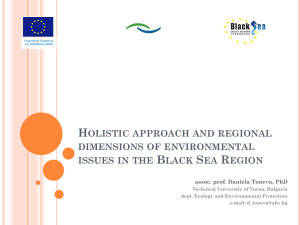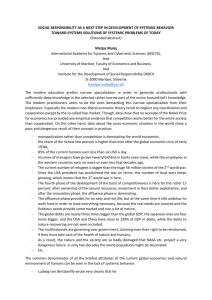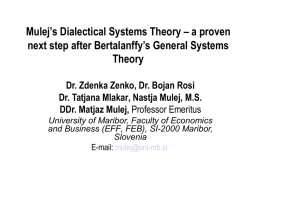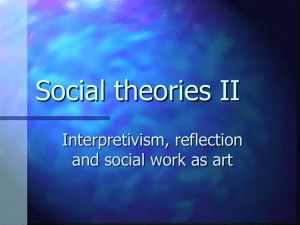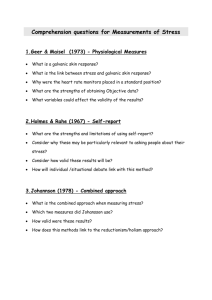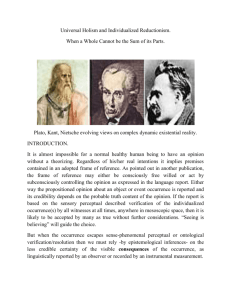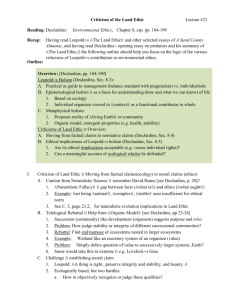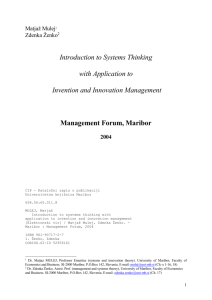What do the EU, the United Nations, the International Standards
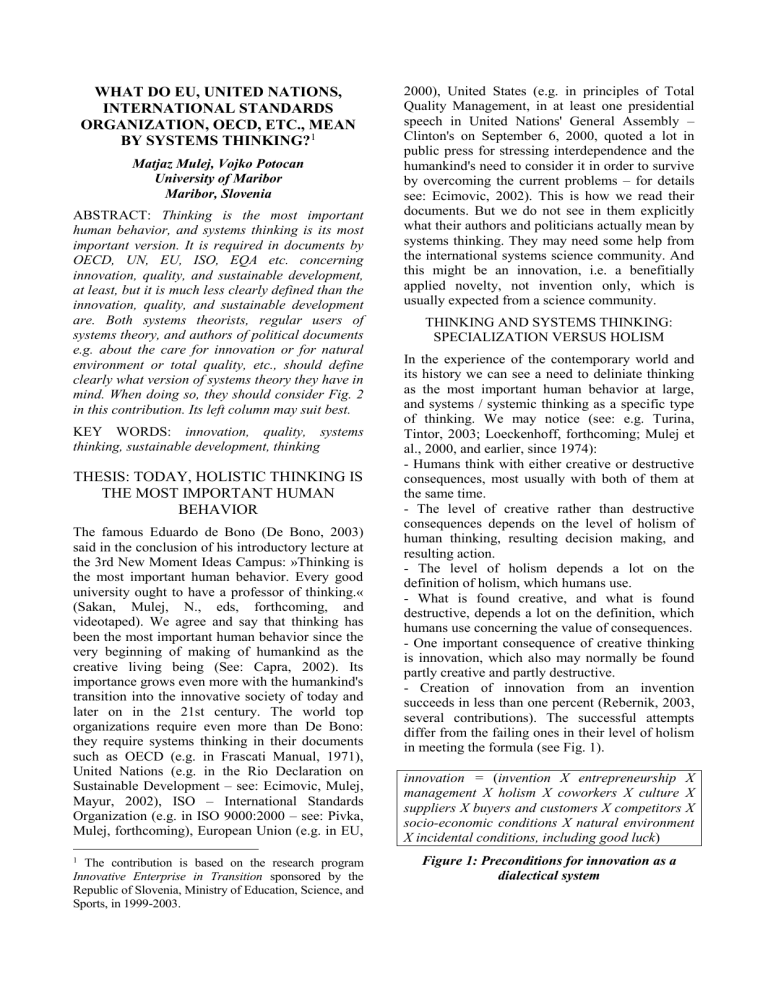
WHAT DO EU, UNITED NATIONS,
INTERNATIONAL STANDARDS
ORGANIZATION, OECD, ETC., MEAN
BY SYSTEMS THINKING?
1
Matjaz Mulej, Vojko Potocan
University of Maribor
Maribor, Slovenia
ABSTRACT: Thinking is the most important human behavior, and systems thinking is its most important version. It is required in documents by
OECD, UN, EU, ISO, EQA etc. concerning innovation, quality, and sustainable development, at least, but it is much less clearly defined than the innovation, quality, and sustainable development are. Both systems theorists, regular users of systems theory, and authors of political documents e.g. about the care for innovation or for natural environment or total quality, etc., should define clearly what version of systems theory they have in mind. When doing so, they should consider Fig. 2 in this contribution. Its left column may suit best.
KEY WORDS: innovation, quality, systems thinking, sustainable development, thinking
THESIS: TODAY, HOLISTIC THINKING IS
THE MOST IMPORTANT HUMAN
BEHAVIOR
The famous Eduardo de Bono (De Bono, 2003) said in the conclusion of his introductory lecture at the 3rd New Moment Ideas Campus: »Thinking is the most important human behavior. Every good university ought to have a professor of thinking.«
(Sakan, Mulej, N., eds, forthcoming, and videotaped). We agree and say that thinking has been the most important human behavior since the very beginning of making of humankind as the creative living being (See: Capra, 2002). Its importance grows even more with the humankind's transition into the innovative society of today and later on in the 21st century. The world top organizations require even more than De Bono: they require systems thinking in their documents such as OECD (e.g. in Frascati Manual, 1971),
United Nations (e.g. in the Rio Declaration on
Sustainable Development – see: Ecimovic, Mulej,
Mayur, 2002), ISO – International Standards
Organization (e.g. in ISO 9000:2000 – see: Pivka,
Mulej, forthcoming), European Union (e.g. in EU,
1 The contribution is based on the research program
Innovative Enterprise in Transition sponsored by the
Republic of Slovenia, Ministry of Education, Science, and
Sports, in 1999-2003.
2000), United States (e.g. in principles of Total
Quality Management, in at least one presidential speech in United Nations' General Assembly –
Clinton's on September 6, 2000, quoted a lot in public press for stressing interdependence and the humankind's need to consider it in order to survive by overcoming the current problems – for details see: Ecimovic, 2002). This is how we read their documents. But we do not see in them explicitly what their authors and politicians actually mean by systems thinking. They may need some help from the international systems science community. And this might be an innovation, i.e. a benefitially applied novelty, not invention only, which is usually expected from a science community.
THINKING AND SYSTEMS THINKING:
SPECIALIZATION VERSUS HOLISM
In the experience of the contemporary world and its history we can see a need to deliniate thinking as the most important human behavior at large, and systems / systemic thinking as a specific type of thinking. We may notice (see: e.g. Turina,
Tintor, 2003; Loeckenhoff, forthcoming; Mulej et al., 2000, and earlier, since 1974):
- Humans think with either creative or destructive consequences, most usually with both of them at the same time.
- The level of creative rather than destructive consequences depends on the level of holism of human thinking, resulting decision making, and resulting action.
- The level of holism depends a lot on the definition of holism, which humans use.
- What is found creative, and what is found destructive, depends a lot on the definition, which humans use concerning the value of consequences.
- One important consequence of creative thinking is innovation, which also may normally be found partly creative and partly destructive.
- Creation of innovation from an invention succeeds in less than one percent (Rebernik, 2003, several contributions). The successful attempts differ from the failing ones in their level of holism in meeting the formula (see Fig. 1). innovation = ( invention X entrepreneurship X management X holism X coworkers X culture X suppliers X buyers and customers X competitors X socio-economic conditions X natural environment
X incidental conditions, including good luck )
Figure 1: Preconditions for innovation as a dialectical system
Basically, we may conclude that prof. De Bono rightly requires every good university to have a professor of thinking. But he would make an even better conclusion, if he required explicitly the holistic thinking. The audiotape of his talk lets us see that this is what he has had in mind, implicitly.
The same may also be what UNO, EU, USA, ISO have had in mind, just as L. v. Bertalanffy has had when formulating the General Systems Theory as
Lehre = Teaching and Education (see for details:
Ecimovic, 2002).
But we know from experience that the
Bertalanffian principle requires more than humans are able and willing to do: fighting the exaggerated specialization, consideration of interdependence due to mutual differences, feeling and behaving like citizens of the entire world, not single countries only, and consideration of the entire biosphere, not single parts of it, such as one's own garden only. This limited human capability is why:
- There are several ten thousand specialized professions around today.
- Insights of specialists are very important and fruitful, but even much more so when linked with the interdependent ones into an emerging synergy, more holistic due to interdisciplinarity.
- Specialization is unavoidable, fruitful and very dangerous, all at the same time: it does not provide insights only, but also crucial oversights, as soon as an interdisciplinary co-operation is lacking.
Therefore, holism is equally unavoidable, but much less practiced and much less defined in a unified version, under the prevailing impact of the growingly narrow specialization.
- Even the system science conferences unavoidably, and regretably, limit their scopes to delimited specializations. Thus, the level of holism, both the defined and the practiced ones, are far away from the Bertalanffian requirement.
Very few systems science conferences explicitly go for interdisciplinarity, and they have a small audience, such as: Problems of.. (de Zeeuw, 1979
– 2001 biannually; Rebernik, Mulej, 1992 – biannually; Chroust, Doucek, Hofer et al, 1993 – annually).
Further on we should consider that:
(1) the acknowledgment of the crucial need for holism, and
(2) the gradual, but rapid prevailing of the innovative society – both have happened after the
2nd World War, actually after the four decades filled with two world wars and the world-wide economic crisis between them, in 1914-1945. The cause of these crises can be seen in onesided rather than holistic thinking, basically.
Further six decades later, one can find one single world-wide problem in which holism has prevailed over the narrow specialization to a requisite extent: use of the nuclear weapons has been prevented.
Even in the similarly crucial topics - sustainable development and climate change - that may ruin the preconditions of the human existence rather soon, the narrow interests and viewpoints prevail over the global ones. – There is a lot of thinking, but it is not requisitely holistic. And it is not requisitely linked with ethics of interdependence
(Mulej et al. 2003a). This makes us perceive one more critical fact: thinking alone may include or disregard the emotional part of the human personality and existence, although the rational and the emotional part are interdependent (see:
Greer 2000). Thinking is not requisitely holistic, if it is rational only.
OUR DEFINITION OF SYSTEMS THINKING
We suggested a definition of systems thinking, which we found requisitely holistic (Mulej et al.,
2003c), and completed it up on the basis of responses received (Mulej et al., forthcoming). We will only summarise it here in Figure 2:
No Systems / Systemic / Holistic Thinking
1 Interdependences, Relations, Openness,
Interconnectedness, Dialectical System
2 Complexity (& Complicatedness)
3 Attractors
4 Emergence
5 Synergy, System, Synthesis
6 Whole, Holism, Big Picture
7 Networking, Interaction, Interplay
Un-systemic, Traditional Thinking
Independence, Dependence, Closeness, A single viewpoint/system
Simplicity, or Complicatedness alone
No influential force/s, but isolation
No process of making new attributes
No new attributes resulting from relations
Parts and partial attributes only
No mutual influences
Figure 2: The Seven Basic Sets of Terms of Systems / Systemic / Holistic vs. Un-systemic Thinking (as a dialectical system)
We can hardly expect all systems theorists and practitioners to agree with our definition, due to the discussed prevailing of specialization over holism. The observing of e.g. systems science conferences makes us see a number of streams in systems theory, such as:
(1) The mathematical stream defining system as an ordered set, meaning that there is a set of components and a set of their relations. It is the most general one and applied by many specialists.
It lets them choose whatever contents they like, even without any definition of it. It therefore allows for any level of holism, because every selected viewpoint allows its author to select the subsystem of the really existing attributes as he or she pleases. Under the name of holism one can attain a total holism or requisite holism or a fictitious holism, the latter one being limited to a single selected viewpoint. They do not seem to care for the dictionaries quoting about 15 groups of the contents of the word system.
(2) The specialists of single disciplines of science, who do not work on mathematics, but use it inside their own fields and their own selected viewpoints, without acknowledging any need for any interdisciplinarity . In terms of Fig. 2, they work on the traditional basis, attaining a limited or fictitious holism. It may allow them deep insights, but no linking of them with insights from other viewpoints, used by different specialists. They do not seem to care for the said dictionaries.
(3) The specialists of single disciplines of science, who do not work on mathematics, but use it inside their own fields and their own selected viewpoints, and acknowledge their need for interdisciplinarity .
In terms of Fig. 2, they do not work on the traditional basis and attain more than a fictitious holism. It may allow them for deeper insights than the ones from group (2), due to linking of them with insights from other, different specialists.
They are many less than the members of groups
(1) and (2). They seem to care for the said dictionaries.
(4) The specialists of systems theories, who explicitly work on systems thinking as a theory of thinking, but do not define the contents of the word system explicitly . They may have the impact over the cited worldwide organizations that use the word systems thinking in their documents without defining it.
(5) The specialists of systems theories, who explicitly work on systems thinking as a mental tool aimed to make bridges between specialists of whatever disciplines and practices . We belong in this group. To us, the central point of the
Bertalanffian systems theory is not the similarity – the isomorphism – allowing for the transfer of notions from one area to another and poorly caring for further cooperation between mutually different disciplines. We rather see the basic notion in the interdependence of them, because they are mutually different and hence needing each other for complementarity aimed at the requisite holism of insight, thus avoiding crucial oversights.
As we have indicated in Fig. 1, innovation is at the same time the basis for survival in the modern global competition, and so complex that it, both as a process and as its outcome, requires systems thinking reaching beyond streams (1), (2), (4) and joining the stream (5) or (3) at least. Keeping to one single viewpoint rather than to a dialectical system of all essential viewpoints very rarely allows for the requisite holism; a single viewpoint uncovers only a subsystem or even a subset of the really existing attributes of any object worked on.
THINKING AND SYSTEMS THINKING
ABOUT INNOVATION
In the contemporary society and economy we see a great impact of creativity of human thinking over human conditions and results of life – in the form of innovation. Understanding of innovation is obviously not unified in practice and was therefore found worth a unified official definition. OECD
(Frascati Manual, 1971) and European Union (EU
1987/1989; EU, 1995; EU, 1996; EU, 2000; EU,
2001; EUR, 2001; as documents on promotion of innovation) define innovation as in Fig. 3. Thus, innovation is equally a notion in economics, law, psychology, sociology, technology/ies, etc., actually in all of them at the same time – making them interdependent. Thus, innovation, both as a process, and as an outcome of it, requires systems thinking (Fig. 2, the left column).
Innovation = every beneficially applied novelty.
The decision, what novelty is an innovation is up to novelty’s user / consumer / buyer, not up to its author / owner / supplier.
Figure 3: Definition of innovation as an outcome
This is in line with the old Schumpeterian definition as well the current ones (e.g. Afuah,
1998) saying: innovation is equal to invention plus commercialization. This leads to Fig. 4:
Innovation = Invention (maybe protected, e.g. by patent) + commercialization = new benefit
Benefit from innovation
= Provided by invention + entire business process (all functions cooperating)
Cooperat- ing ones for innov.
= Authors of invention + all coworkers, including managers with requisite skills
Skills re- quired from the co-operating ones
= Requisite professions, creativity, entrepreneurship, management, routine, co-operation capacity, ethics of interdependence, all of them as a dialectical system
Figure 4: From invention to innovation – the need for systems thinking about it
On the other hand, the Journal of Economic
Literature limits innovation to the technological innovation only by e.g. its classification. (JEL
2003). This is a much narrower and hence out-ofdate definition than in Figures 3 and 4. Such a limitation may be a consequence of the fact that patenting is much older than the science of economics, business, management, organization, marketing etc. (see: CJE, 2003). Patenting is an important tool of promotion of science and its potential (!) application in the industrial and other parts of the ‘real’ world. It has been limited to technical and technological inventions only, and inventions were not delineated from innovations, as they are today. Today, it is clear from official data, that only a small fraction of inventions (one percent at most), even if patented, become innovations, and that the technical and technological innovations are far from a dominant percentage and an exclusive importance.
(Rebernik, 2003, several contributions)
Thus, the still prevailing traditional thinking about invention and innovation, be it from the inventioninnovation process viewpoint or from its outcome viewpoint, has not been requisitely holistic. This fact may explain, partly at least, why the success rate of this process is so very low. Hence, OECD seems to have been hardly understood, in its
Frascati Manual of 1971. It was a number of years later when the economic historians showed their discovery that the most important innovation of the modern times was the innovation of management in the form of abolishment of guilds’ and churches’ monopoly over the free competition of products and ideas (Rosenberg, Birdzell, 1986).
It freed entrepreneurship, caused the supply to exceed demand, thus causing the need for inventions and making innovations from them – in a quite complex process, briefed above in Fig. 1, 3 and 4. This is why systems thinking, as defined in the left column of Fig. 2 is so necessary.
Hence, EU is right when requiring systems thinking about innovation (both as a process and as its outcome) explicitly. So are the legislators of the ISO 9000:2000 standard on quality and of the
EQA (European Quality Award), TQM rules in
USA, Deming Prize rules in Japan, etc., although they require systems thinking a bit more implicitly
– by requiring innovation to be a basis of the quality, and by requiring the quality of the entire business rather than products only.
Implicitly, United Nations also requires systems thinking in its documents concerning the balancing of the economic development and the natural environment of humankind: speaking of the sustainable development requires us to see their interdependence rather than independence. Even more, it requires the Bertalanffian style of systems thinking, using the total system, not the dialectical system and even less the one-viewpoint system.
(See: Ecimovic, 2002, for details)
Newer versions of thinking about the sustainable development are closer to the left column in Fig. 2 by explicitly linking the social, economic and ecological viewpoints. In addition, the conference of European ministers responsible for regional development, held in October 2003 in Ljubljana and Maribor, Slovenia, supported and immediately included in their conference proceedings our suggestion that the ethical imperative should be added and that all four imperatives should be seen in full interdependence, as a four-leaf clover
(Tavcar, Mulej, 2003; see also: Tavcar, 2003).
As we see, there are discrepancies between different parts of the world’s governing bodies, including the world top international bodies. JEL, e.g., does not speak of systems thinking, and limits innovation to technological innovation, even now, more than 15 years after the publication of the book – by economic (!) historians – showing that the most crucial innovation is the innovation of management. JEL never mentions this term. This innovation is anyway the precondition for all other innovations to show up, including the technological ones; this is the message of the
recent history. It is still very poorly accepted in practices of both economy and academia: the lack of systems thinking about management causes the use of the human resources in USA to be about 23 percent only (Ackoff, 2003) and makes universities unable to meet modern requirements
(Ackoff, 2001). Governments do not seem to be much better, if at all.
This is why we suggest the statement in the left column in Fig. 2 to be accepted as a suitable definition of what is meant by systems thinking, including the one about innovation, both as a process and as its outcome. The practice of innovation is too complex for any one-sided thinking to be good enough to provide for success.
This fact is increasingly important in the contemporary global economy.
The purely descriptive and one-sided versions of systems theory can no longer meet all demands.
And the principles of the Dialectical Systems, chaos, and complexity theories, lie much closer to consideration of interdependence on the level required by Bertalanffy. They seem to replace the traditional systems theory rather than to be considered a modern stream among all systems theories. (See for some details: Mulej et al. 2000;
Ecimovic, 2002). Systems theorists should think more about the Fig. 2, apparently.
MAIN-STREAM THEORISTS DO NOT SPEAK
MUCH ABOUT THE INTERDEPENDENCE OF
SYSTEMS THINKING AND INNOVATION
If there is no unified definition of systems theory and systems thinking, and if there is such a big need for systems thinking about innovation as UN,
EU, OECD, EQA, ISO, Deming Prize etc. are telling us, what are the main-stream theorists saying in order to meet this crucial need of the modern humankind? We tried to investigate this issue by analyzing the books and the published references about research connecting systems thinking and innovation. We limited our investigation to references starting from their interdependence or dependence of one of them on the other, and stating synergies or using synergies in their dealing with the two. The entire list of references cannot be published in this paper due to lack of room (see Goldblatt, Spreng, 1998;
Aronson, 1998; Fisher, Snickars, Diez, 2002;
Goldberg, 2002; Mjoset, 2002, Sim, 2002; Pyka,
Kuppers, 2002: etc.). Results of the comparative analysis of the references accessible and accessed by us recently include:
- Problems of a unified definition and perception of contents of the basic terms (e.g. what is systems theory all about, what is innovation all about, what is their mutual impact like, what is their interdependence like) have no unified solutions.
- The amount of references trying to “holistically and realistically” deal with the links of the systems theory and innovation – makes a small fraction of all the literature working on either systems theory/ies or innovation.
- The literature detected hardly includes the mainstream authors in either area.
- The literature surveyed demonstrates very different understandings, approaches, and ways of working on the topics under consideration.
- Many references working on the relation between systems theory and innovation are goal-oriented to meet requirements of investigation in single specific areas, such as Information Systems,
Information Technology, Marketing, R&D,
Complexity, Chaos Theories.
- There are a few references starting from the systems theory and upgrading it to innovation.
- Most investigations deal with the technological innovations, much less the other types, e.g. business programs, management, organization, methods of work, etc.
Hence, one can hardly be happy with the situation detected concerning the interplay of systems and innovation theories: neither can the innovation theory be requisitely holistic nor can the systems theory be requisitely innovated, and in line with the original idea of L. V. Bertalanffy that we should consider the entire world as one organization full of interdependencies, and care for the entire biosphere, in order to survive, which we cannot with an exaggerated overspecialization alone (Bertalanffy, 1979; Davidson, 1983; Elohim,
1979; see: Ecimovic, 2002, for details).
CONCLUSION AND RESULTING
SUGGESTION
Both systems theorists, regular users of systems theory, and authors of political documents e.g. about the care for innovation, total quality, or for natural environment, etc., should define clearly what they mean by systems theory, as they have about innovation, total quality, sustainable development. When doing so, they should consider Fig. 2. above.
REFERENCES:
Ackoff, L. R. (2001): Interaction among departments is crucial. Interview by D. Staffors, Kansas City Star, 30
July, 2001; sent via e-mail to M. Mulej by John
Donges, jdonges@seas.upenn.edu, 04 Sept., 2001.
Ackoff, L. R. (2003): Iconoclastic management authority advocates a »systemic« approach to innovation. Interview by Robert J. Allio. E-mail to M.
Mulej from: Ackoff Center: acasa@seas.upenn.edu, 11
July, 2003.
Afuah, A. (1998): Innovation Management – Strategies,
Implementation, and Profits. Oxford University Press,
New York etc..
Aronson, D. (1998): Using Systems Thinking to
Increase the Benefits of Innovation Efforts. R&D
Innovator , Vol. 6. No. 2..
Beck, U. (2003): What is Globalization. Delo , October and November. (In Slovene)
Capra, F. (2002): The Hidden Connections. Doubleday,
New York.
Davidson, M. (1983): Uncommon Sense. The Life and
Thought of Ludwig von Beralanffy, Father of General
Systems Theory. J. P. Tarcher, Inc., Los Angeles
De Bono, E. (2003): Thinking. In: Sakan, D., Mulej, N., eds. (forthcoming): Think Like Leonardo. New
Moment . Available on videotape from editors, New
Moment, d.o.o., Ljubljana.
Ecimovic, T., Mulej, M., Mayur, R. (& coauthors)
(2002): Systems Thinking and Climate Change System.
Institute for Climate Change, Korte.
Elohim, J. L. (1999: A Letter from Prof. Elohim. Poster.
11th WOSC Conference, Uxbridge
EU (1987/1989): Miege, R., Mahieux, F., eds. (1989):
Training in Innovation Management. Commission of
European Communities, Directorate-general for Telec.,
Info. Industries and Innovation. Luxembourg.
EU (1995): Green Paper on Innovation. www.cordis.lu/cordis/grnpaper.html.
EU (1996): Action Plan for Innovation in Europe.
European Commission, Brussels.
EU (2000): Communication from the Com. to the
Council and the European Parliament: Innovation in a
Knowledge-driven Economy. Commission of the
European Communities, Brussels.
EU (2001): European Trend Chart on Innovation.
Brussels. Eu. C., Directorate-Gen. for Enterprise.
EUR 17036 (2001): Innovation policy issues in six candidate countries: The challenges. Cyprus, Czech
Republic, Estonia, Hungary, Poland and Slovenia.
Luxembourg. European Commission, DGE
Fisher, M., Snickars, F., Diez, J. (2002): Metropolitan
Innovation Systems . Springer-Verlag, Berlin.
Goldberg, D. (2002): The Design of Innovation . Kluwer
Academic Publishers, Boston.
Goldblatt, D., Spreng, D. (1998): Innovations in Energy
Efficiency. AGS, Zurich.
Greer, W. B. (2000): Ethics and Uncertainty. The
Economics of John M. Keynes and Frank H. Knight.
Edward Elgar. Cheltenham, UK, Northampton, Ma,
USA JEL (2000 and later). www.econlit.org.
Loeckenhoff, H. (Forthcoming): Modelling Innovation
For Creativity Control. In: Trappl, R., ed. (2004):
ECMSR. Proceedings. OeSGfK, Vienna.
Mjoset, L. (2003): Notions of Theory in the Study of
Innovation Systems. In: Proc. Of First Globelics
Conference . Rio de Janeiro, November, 2-6, 2003.
Mulej, M., et al (2000): The Dialectical and Other
Softsystemic Theories – a Basis for Holism and Success of Management. UMaribor, EPF, Maribor.
Mulej, M., et al. (2003): Program Aspects of
Management), 13th ed.. UM EPF, MBA, Maribor
Mulej, M., Kajzer, S., Zenko, Z., Potocan, V. (2003a):
The Bertalanffian Systems Theory as a Basis for Ethics of Interdependence, Unavoidable in the Innovative
Society and Global Economy. Nase gospodarstvo , 49,
3-4, pp. 196-215. (In Slovenian)
Mulej, M., Potocan, V., Zenko, Z., Kajzer, S., Ursic, D.,
Knez-Riedl, J., Lynn, M., Ovsenik, J. (forthcoming): How
To Restore Bertalanffian Systems. Kybernetes.
Pivka, M., Mulej, M. (forthcoming): Requisitely
Holistic ISO 9000 Audit Leads to Continuous
Innovation/Improvement. Cybernetics and Systems. An
International Journal.
PODIM 24 (2003): Dostop do virov za prenos invencij /
Access to Resources for Invention Transfer . IRP
Maribor, et al (several contributions). Edited by:
Rebernik, M., Mulej, M., Rus, M..
Pyka, A., Kuppers, G. (eds) (2003): Innovation
Networks: Theory and Practice . Allyn and Bacon,
Boston.
Rosenberg, N., Birdzell, L. E. (1986): The Past. How the West Grew Rich. Basic Books, New York.
Sakan, D., Mulej, N., eds. (forthcoming): Think Like
Leonardo. New Moment .
Sim, E. (2002): A comparison of Adaption-Innovation
Styles Between Information Systems Majors and
Computer Science Majors. Journal of Info. Sys.
Education , Vol. 13, No. 1.
Tavcar, J. (2003): A four-leaf clover, fortunatelly. In:
Vizija trajnostnega razvoja Slovenije . ICDS, Ljubljana.
Tavcar, J., Mulej, M. (2003): Novel concept of holistic sustainable regional development planning. In: .
Consequences of the EU Enlargement. Ed. by P.
Demsar Mitrovic. Ministry of Env., Spat. Planning and
Energy, Rep. Slovenia, Ljubljana.
Turina, A., Tintor, J. (2003): Systems Thinking as a
Key Approach to Problem Solving. In: Chroust, G.,
Hoffer, C., Doucek, P. (eds): IDIMT 2003. Trauner,
Linz.
